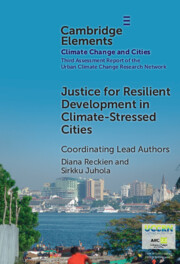Refine search
Actions for selected content:
335 results
3 - Robots, Humans, and Their Vulnerabilities
- from Part I - Conceptualizing the Digital Human
-
-
- Book:
- Being Human in the Digital World
- Published online:
- 11 November 2025
- Print publication:
- 20 November 2025, pp 28-44
-
- Chapter
-
- You have access
- Open access
- HTML
- Export citation
Vulnerability to and acceptability of different types of sludge
-
- Journal:
- Behavioural Public Policy , First View
- Published online by Cambridge University Press:
- 03 November 2025, pp. 1-30
-
- Article
-
- You have access
- Open access
- HTML
- Export citation
Chapter 15 - Substance Misuse in Young People
-
-
- Book:
- Seminars in Child and Adolescent Psychiatry
- Published online:
- 10 October 2025
- Print publication:
- 30 October 2025, pp 231-243
-
- Chapter
- Export citation
14 - Non-discrimination and Equality
-
- Book:
- Human Rights Law in the UK
- Published online:
- 11 November 2025
- Print publication:
- 30 October 2025, pp 764-859
-
- Chapter
- Export citation
Climate-related vulnerabilities and the European Court of Human Rights: Reimagining victim status through intersectional thinking
-
- Journal:
- Leiden Journal of International Law , First View
- Published online by Cambridge University Press:
- 15 October 2025, pp. 1-24
-
- Article
-
- You have access
- Open access
- HTML
- Export citation
5 - Lessons from Existing International Institutions to Represent Vulnerable Groups
- from Part II - International Law and Institutions
-
- Book:
- Representing Future Generations
- Published online:
- 19 September 2025
- Print publication:
- 09 October 2025, pp 116-142
-
- Chapter
- Export citation
5 - Use Case 2: Commercial Advertising
-
- Book:
- A Datafied Mind
- Published online:
- 27 September 2025
- Print publication:
- 09 October 2025, pp 89-118
-
- Chapter
- Export citation
9 - Conclusion
- from Part III - Case Studies
-
- Book:
- Representing Future Generations
- Published online:
- 19 September 2025
- Print publication:
- 09 October 2025, pp 220-232
-
- Chapter
- Export citation
3 - The Democratic Ideal and Its Normative Value for Future Generations
- from Part I - Normative Framework
-
- Book:
- Representing Future Generations
- Published online:
- 19 September 2025
- Print publication:
- 09 October 2025, pp 48-90
-
- Chapter
- Export citation
5 - Irritation
- from Part III - Unsettling Environments: Threat, Loss, and Precarity in Russia’s Peatlands
-
- Book:
- Burning Swamps
- Published online:
- 06 September 2025
- Print publication:
- 25 September 2025, pp 171-197
-
- Chapter
- Export citation
1 - Reconsidering Disaster Risk
-
- Book:
- Legacy in the Landscape
- Published online:
- 11 November 2025
- Print publication:
- 11 September 2025, pp 1-12
-
- Chapter
- Export citation
Chapter 7 - Laugh No Limit
- from Part II - Interpretation and Meaning
-
-
- Book:
- The Cambridge Companion to Stand-Up Comedy
- Published online:
- 21 August 2025
- Print publication:
- 04 September 2025, pp 140-157
-
- Chapter
- Export citation
Chapter 10 - Expressions of School Maladjustment
-
- Book:
- School Adjustment
- Published online:
- 29 August 2025
- Print publication:
- 07 August 2025, pp 319-344
-
- Chapter
- Export citation
What Is the Point of Harm Reduction? A Relational Egalitarian Perspective
-
- Journal:
- British Journal of Political Science / Volume 55 / 2025
- Published online by Cambridge University Press:
- 04 July 2025, e89
-
- Article
-
- You have access
- Open access
- HTML
- Export citation
Chapter 5 - Groups of Prejudice and Intolerance
- from Section 1 - Typology
-
-
- Book:
- A Clinical and Forensic Guide to Cults and Persuasive Leadership
- Published online:
- 19 June 2025
- Print publication:
- 03 July 2025, pp 87-117
-
- Chapter
- Export citation
Vulnerability and Critical Human Security in the Era of COVID-19 and Beyond in the UK and South Korea – ERRATUM
-
- Journal:
- Social Policy and Society / Volume 24 / Issue 3 / July 2025
- Published online by Cambridge University Press:
- 12 September 2025, p. 498
- Print publication:
- July 2025
-
- Article
-
- You have access
- Open access
- HTML
- Export citation
7 - Loss and Damage Policy in Bangladesh
-
-
- Book:
- Governing Climate Change Loss and Damage
- Published online:
- 10 June 2025
- Print publication:
- 26 June 2025, pp 130-159
-
- Chapter
-
- You have access
- Open access
- HTML
- Export citation

Justice for Resilient Development in Climate-Stressed Cities
-
- Published online:
- 12 June 2025
- Print publication:
- 10 July 2025
-
- Element
-
- You have access
- Open access
- HTML
- Export citation
Introduction
-
-
- Book:
- Complex Ethics Consultations
- Published online:
- 17 May 2025
- Print publication:
- 05 June 2025, pp 1-3
-
- Chapter
- Export citation
Loneliness and Ressentiment
-
- Journal:
- Journal of the American Philosophical Association / Volume 11 / Issue 4 / December 2025
- Published online by Cambridge University Press:
- 13 May 2025, pp. 677-695
-
- Article
-
- You have access
- Open access
- HTML
- Export citation
